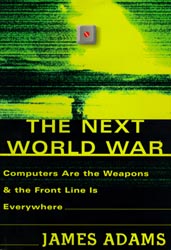Chris Mitchell
James Adams is the former defence correspondent for the Sunday Times and the author of several books about the changing role of the world’s military forces in the post-Cold War climate. The Next World War examines the impact of technology on the future of armed conflict and the decisive importance of what has become known as information warfare.
For the soldier in the field, information warfare is simply a fulfilment of Sun Tzu’s maxim “Know your enemy and know yourself”. It means gaining complete information concerning the enemy’s strength and location first thanks to surveillance and intelligence.
This new form of warfare was characterised by the Gulf War’s near absence of physical contact between Allied and Iraqi forces. With the Americans’ unparalleled surveillance technology as well as long range missile and bombing capabilities, the war was fought almost by remote, maximising the Americans’ information advantage and minimising the risk to their own troops.
However, the increased reliance on microchips in both military and civilian life makes them vulnerable to another form of information warfare: hacker attack. As the world’s most technologically advanced power, Adams maintains that the US is also the most exposed to the disruption and destruction of its infrastructure by non-military means from anywhere in the world.

Despite his book’s UK subtitle “The warriors and weapons of the new battlefields in cyberspace”, Adams seems to have little conviction that on-line skirmishes between hackers and government agents will replace real warfare. While he darkly notes the “what if?” implications of a couple of low-level hacks on US military databases by mischievous teenagers, Adams remains frustratingly vague about where these attacks would come from, what they would try to achieve and exactly how they would do it. It begs the question that if it really is so easy to hack the Pentagon’s computers and cause widespread disruption, then why hasn’t someone done it yet?
Adams is far more comfortable discussing the role of the American soldier using new technology, which takes up the great majority of his book. Chapters on the use of the media to disinform the enemy, the state of post-Cold War espionage and the development of non-lethal weapons are also all lumped in under the umbrella of information warfare. While this provides a multifaceted survey of the modern military machine, it also sacrifices any real depth of analysis or thematic cohesion.
Furthermore, while Adams lays out all the arguments against the idea of there actually being another world war due to the way that armed conflict has so radically changed, he fails to move away from the traditional paradigm of the combat zone and fully explore the new methods of waging war by non-military means.
